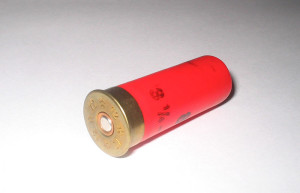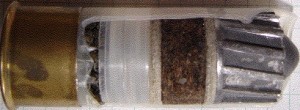
Yesterday, I discussed Shotgun Cartridges, Components, and Shell Sizes, so today I wanted to dive a little further into the slugs, slug types, shots and shot sizes, and the best shot uses for different game.
I guess that I will first go over the slug. Slugs have the advantage of adding a single solid mass to place all the force generated in one spot allowing for a much greater impact or penetration on larger game. It brings a little bit of the “rifle” element to the shotgun, even though the shotgun was created specifically for shotshells that were at one time used in muskets. The Types of Shotgun slugs are the “pumpkin ball”, Brenneke, Foster, Saboted Slugs, Wad Slug, Plumbata, and Steel. there are also the homemade types of slugs called the wax slug and the cut shell slugs. Both of those have large disadvantages, but were used in the great depression. That can be a lesson in itself.
Pumpkin Ball: This was probably one of the first slug shots. It is just a round lead ball that was just smaller than the bore of the gun allowing it to be able to be safely shot. It is not extremely accurate and has limited range. It is about 25-50 yards at the long end.

Brenneke Slugs: They were designed in the late 1800s and had what looked like a “rifling of the bullet”. It really did nothing to add spin to the slug. It reduces surface area in contact with the barrel, reducing friction, and raising exit velocity. Because it is a solid slug, the brenneke had stabilization problems, so it was designed with a small amount of wad that stays attached to the back of the slug to help with gas sealing, but mostly for creating drag for slug stability in travel. It is good at about 50-75 yards.
Foster Slugs: This slug had a hollowed out rear that allowed the mass to be near the tip, allowing for stable air travel. It was designed for use during the Great Depression. Cast from soft lead, it was designed for use in a smooth barrel with choke. It also has the “rifling” on it, but once again, just like the Brenneke slugs, it is for reduced friction, not for spin. The hollowed out design and rifling slits on it make the foster extremely manageable in choked barrels. The foster has a range of about 75 yards.
Saboted Slugs: This slug is known more for the plastic around it. The sabot is a jacket that pretty much encases the entire slug. The slug is smaller to account for the added plastic. The sleeve is typically used in rifled barrels. It catches the rifling adding stabilizing spin to the slug giving it a range of 330 yards when fired from the rifled shotgun. The crazy thing about this slug… Even though it is great for rifled barrels, the sabot was designed initially for smoothbore guns.
Wad Slug: The wad slug is nothing extremely fancy. It is a mix of the foster and the sabot. It has a hollow at the back, that is filled with a key… therefor the name “Key Slug.” It also has a design so it can be placed in a typical shot wad. The wad can catch rifling to assist a little, but it is a smoothbore slug and has about the same range of 75 yards as the foster. Then why use it? The Wad Slug, since it fits into a standard wad, can be reloaded using standard loading equipment.
Plumbata: These slugs have two designs. One design has a portion of wadding that is designed into the tail end of the slug, meant to stick with it through flight for stabilizing. It can be designed with sabots on it as well. Another design, wraps around the base of the slug and engages grooves into the slug. It can already act as a sabot and is called “Impact Discarding Sabot”.
Steel: Must be saboted, so it doesn’t damage the barrel. I don’t really see a general use for this one as it is expensive to make compared to the lead slug. They are best suited for dense brush and disabling vehicles, although there are many rifles that are better for that.
Now for Wax and Cut Shell: Both were used during the Great Depression. Wax slug was made by removing shot out of the shell, melting parafin wax and adding the shot. Then spooning the wax and shot back into the shell, with the shell slightly cut back. Wax is bad about building up, so I would advise against it. There was no crimping necessary since the parafin held it in. If in a scenario that you need to use the wax, you should clean your shotgun extremely well afterwards. It had a range of around 50 yards. The Cut Shell was basically cutting the shell almost dead center of the wad so that it will fail prior to the crimping of the shotshell. It was around the entire diameter and went almost through the shell. Problem: Higher chamber pressures and some of the shell could hang around in the barrel. With a range of 35-40 yards, it was usually made in the field on the spot for larger game that showed up. There was no need for pumpkin ball casting.
Now for shot sizes. I will give some basic information on shot sizes, but check out the photo I have provided for a pretty cool explanation.
There are two basic shot groups of shot. Buckshot and Birdshot. Birdshot is useful for fowl, and small to medium game. Buckshot is meant for larger animals, but contrary to the name, it has its fair share of failures penetrating deer. It is best to use slugs, if possible. Light buckshot however makes a great home defense round.
As with gauge, the shot size is larger for a smaller size number. I would go into the details, like I did with the slug, but why when I made a nifty chart with Shot size info and shot use info: